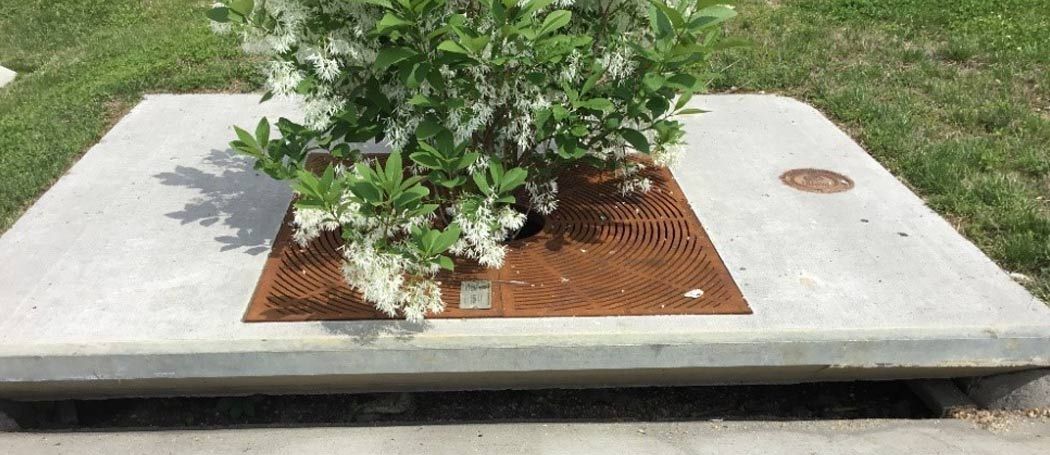Anatomy of a Filterra
by Jason Abert, Vice President of Service Delivery
Knowledge of how Stormwater SCMs work is crucial to have to recognize when one of your structures may be failing. Two very important disciplines within stormwater management are drainage and filtration. Filterra units combine drainage and filtration into a single aesthetically pleasing structure.
Filtration
Filtration is one of the most important tools for good stormwater management at a facility. In a natural setting, rainwater can soak into the ground to allow pollutants to filter out before being reused in the water cycle. Due to the impervious nature of asphalt and concrete surfaces in parking lots and buildings, water is not able to infiltrate and instead travels directly into streams and rivers in the watershed. This runoff brings with it any pollutants that it may pick up along the way. Some common runoff pollutants include nickel, which is a byproduct of gasoline combustion, and phosphorus, which can be found in most fertilizers. To prevent contamination of streams and rivers, researchers have engineered proprietary systems that engage in processes to remove pollutants before they reach vital waterways. Filterras, as their name suggests, help filter stormwater in an environmentally friendly way.
How do Filterras work?
All Filterras have a few basic components that allow them to filter water naturally. The outside has a drain grate with an opening at the top that allows a plant to grow. Stormwater runoff enters through an inflow beneath the grate, like a normal curb inlet. From there, large debris and trash are captured by the mulch layer. This layer should be cleaned out as needed. AQUALIS regularly cleans debris from mulch layers during routine preventative maintenance services. Once an inspection reveals that sediment buildup is preventing filtration efficiency, the mulch layer is replaced. After passing through the mulch layer, stormwater travels down the soil layer and through the filter media. Pollutants are absorbed by plant media roots. Clean water then filters down into an underdrain where it connects with the rest of the system to eventually be discharged. A second inlet without filter media will typically be installed downstream. In the event of an extremely high rain event, the water will drain quickly into this second inlet to prevent flooding. When properly maintained, Filterras can be an efficient, environmentally friendly method to both drain and filter stormwater before it returns to the ecosystem.
Why use Filterras?
Filterras are best used in highly urbanized areas. They are a great way to add functional greenspace to an area that might otherwise be lacking. Filterras efficiently remove phosphorous from stormwater, among other pollutants. Phosphorous in stormwater runoff commonly originates from fertilizers and organic waste. If phosphorous isn’t filtered, it can cause eutrophication in bodies of water, harming aquatic life. Plant roots in Filterras will absorb phosphorous as a nutrient before it has the chance to be released and cause harm.
What types of vegetation to use?
The vegetation is the most crucial component to the success of a Filterra. However, when it comes down to choosing a plant, the options can be a bit overwhelming. Typically, using vegetation that naturally grows in the area is the best option, and there are specific plants required by the manufacturer. If you notice that the plant in your system is dying, it may be because the wrong type of vegetation is being used. Luckily, AQUALIS has an extensive botanical knowledge and can help you select the best tree or shrub to ensure your systems efficiency and longevity.
Common Issues
Filterras can suffer from many of the same issues as typical catch basins. Concrete riser blocks sit below the surface and helps raise the Filterra to match the existing elevation. Riser damage can cause sinkholes to form in and around the structures. This allows water to either pool around the structure or incorrectly infiltrate into the system, bringing sediment and other pollutants with it. Another common maintenance issue with Filterra units are the buildup of debris. It is critically important that the opening of the unit is not blocked and that no material is stored in the flow path of the unit such that the material will quickly clog the filter media. If the inlet or underdrain is blocked with heavy debris, it will not be able to drain to the system causing the water to pool. Finally, the most apparent sign of an issue with a Filterra is dead vegetation. A dead tree will not absorb any pollutants through its roots. If you notice any of these issues occurring in your system, or if you have recently installed a unit that needs maintenance, it’s time to call AQUALIS. Our maintenance and repair teams will ensure that your Filterra units are regularly inspected and operating at peak efficiency.
Sources
Filterra® Bioretention. (n.d.). Retrieved May 17, 2019, from https://www.conteches.com/stormwater-management/biofiltration-bioretention/filterra


